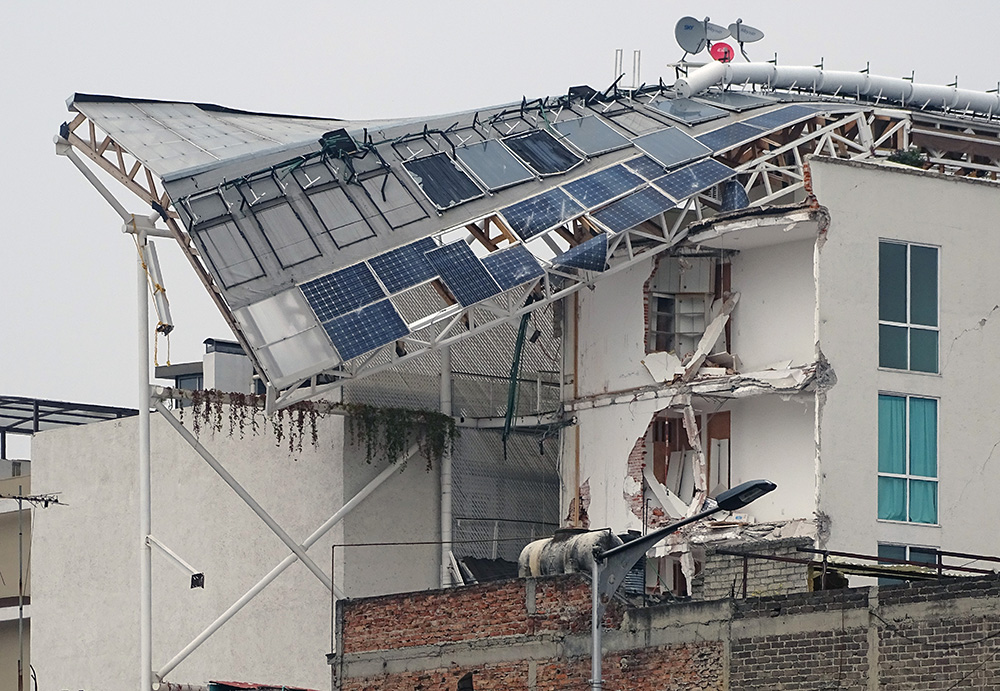Day three begins with Team 1 heading towards the Historic Center of Mexico City to make visual assessments of any buildings that may have been damaged near the Zócalo, Mexico City’s main plaza.
 We scanned and photographed buildings along our path to note and document any damage that was observable from the exterior. We noticed that many modern high rises along our route did not appear to have much significant exterior damage from the recent seismic events. Most of the damage was observed in buildings that were mid-rise or shorter. The 1956 Torre Latinoamericana tower, which was the first major skyscraper successfully built in a high seismic area and had survived the 1985 earthquake undamaged, appeared to not have sustained major damage.
We scanned and photographed buildings along our path to note and document any damage that was observable from the exterior. We noticed that many modern high rises along our route did not appear to have much significant exterior damage from the recent seismic events. Most of the damage was observed in buildings that were mid-rise or shorter. The 1956 Torre Latinoamericana tower, which was the first major skyscraper successfully built in a high seismic area and had survived the 1985 earthquake undamaged, appeared to not have sustained major damage.
At the Historic Center of Mexico City, we found that the cathedral, which survived the 1985 earthquake and was retrofitted, still stood and also appeared not to have suffered major damage. It was encouraging to see both the Torre Latinoamericana and the cathedral survive another major event. As the team explored further, it was noted that very few of the buildings in the area of the Historic Center of Mexico City had observable exterior structural damage. All of the structures were being used as their typical occupancy type and it was business as usual.

We then began our investigation into the potential collapsed building locations marked by others using the Mapa de Edificios Derrumbados y Danados por el Sismo del, which translates to “Map of Buildings Collapsed and Damaged by the Earthquake.” No collapsed buildings were observed for many of the locations that we visited. This may have been because those marking the locations were understandably concerned about the safety of the buildings in which they lived and desired that they be investigated soon by a Director Responsible de Obra (DRO). The DROs are currently understood as being the individuals who are professionally qualified and tasked with inspecting structures and officially determining the level of safety. They also determine the next steps to be taken.

At one of the collapsed building sites, we found a 5-story structure that had columns at the first floor that appeared to be sheared through the middle of the span. This would indicate that the building may be on the brink of collapse. A soft-story irregularity, generally where a floor is considerably less stiff than the ones above, is likely the cause. As we were photographing a collapse of what was possibly a relatively new building across the highway, the DRO arrived to inspect a structure adjacent to us.

The building across the highway from our site appeared to be a 5-to-7 story structure that suffered a partial collapse. The truss supported roof, distinguished by solar panels, tanks, and satellite dishes, still sheltered the area of the collapse.
Team 1 visited four collapsed building locations by the end of the day. At each location, either the police or military police were sent to ensure that the area was kept clear. It was heartbreaking to see the flowers left by loved ones of the victims of the collapses. As one person explained to us yesterday, most people are unsure if their homes are safe to occupy. The uncertainty and waiting must be unbearable and quite frustrating. For our remaining time here, it is important that we learn from this event to help improve the earthquake performance and resiliency of our buildings and infrastructure. In addition, by offering our assistance when we can and performing safety assessments, we can help the community recovery efforts.



Great to see one of AWWUs previous interns out taking charge and helping in a disaster.